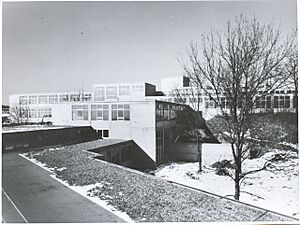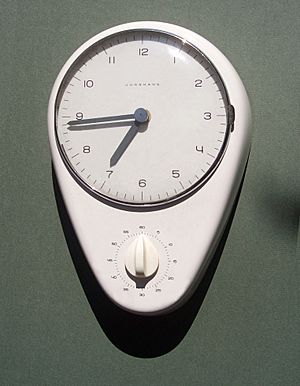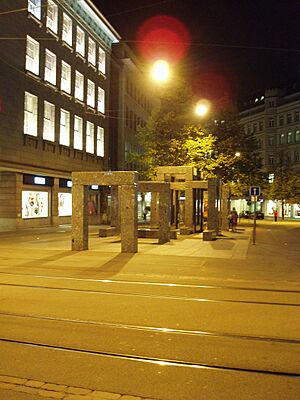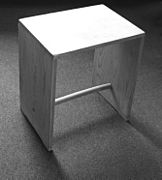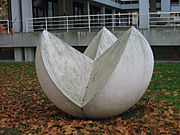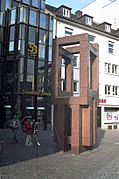Max Bill facts for kids
Quick facts for kids
Max Bill
|
|
|---|---|
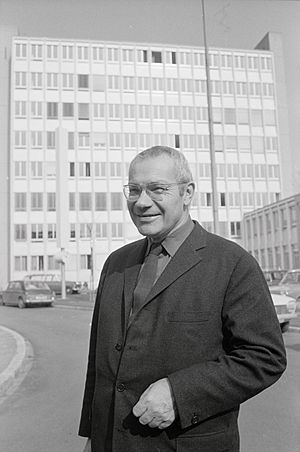
Max Bill in 1970.
|
|
| Born | 22 December 1908 |
| Died | 9 December 1994 (aged 85) |
| Nationality | Swiss |
| Occupation | Architect Artist Painter Typeface designer Industrial designer Graphic designer |
Max Bill (born December 22, 1908 – died December 9, 1994) was a talented Swiss artist. He was many things: an architect, a painter, a typeface designer (someone who creates fonts), an industrial designer (someone who designs products), and a graphic designer (someone who designs visuals for things like posters or websites).
Contents
Early Life and Education
Max Bill was born in Winterthur, Switzerland. When he was young, from 1924 to 1927, he learned how to be a silversmith. This means he learned to work with silver.
After that, from 1927 to 1929, he went to a famous art and design school called the Bauhaus in Dessau, Germany. He learned from amazing teachers like Wassily Kandinsky and Paul Klee. After his studies, he moved to Zurich.
Max Bill's Amazing Work
Art and Design Creations
Max Bill started by creating graphic designs for new, modern buildings. Then, in 1932–1933, he built his very first building: his own house and art studio in Zurich. From 1937, he became a key member of the Allianz group, a group of Swiss artists.
Max Bill had a huge impact on Swiss graphic design starting in the 1950s. His ideas and designs were very important. He had a strong connection to the "Modern Movement" in art, which gave him special authority.
As an industrial designer, Max Bill's work was known for being clear and well-proportioned. For example, he designed elegant clocks and watches for Junghans, a company he worked with for a long time.
One of his most famous designs is the "Ulmer Hocker" (Ulm Stool) from 1954. This stool is clever because it can also be used as a shelf, a small table, or even a speaker's stand! Max Bill created it with another designer, Hans Gugelot. But it's often called the "Bill Hocker" because Max Bill drew the first idea for it on a napkin!
Max Bill wanted his art and designs to show the ideas of new science from the early 1900s. He aimed to create objects that helped people understand these new ideas through their senses. He called this "concrete art," meaning art that is real and can be experienced.
He made simple, geometric paintings and round sculptures. Some of his sculptures were even based on the Möbius strip, a shape with only one side! He used materials like stone, wood, metal, and plaster. His architectural projects included an office building in Germany, a radio studio in Zurich, and a bridge in eastern Switzerland.
He kept designing buildings, like a museum of modern art in Florence (1981) and the Bauhaus Archive in Berlin (1987). In 1983, a large granite sculpture he made, called Pavillon-Skulptur, was placed next to the Bahnhofstrasse, Zürich street. Like many modern art pieces in public, it caused some discussion. His sculpture Endlose Treppe (Endless Stairs) from 1991, made of North American granite, was designed for the philosopher Ernst Bloch.
In 1982, Max Bill received the Sir Misha Black award for his design work.
Teaching and Influence
In 1944, Max Bill became a professor at the Kunstgewerbeschule Zürich (a school of arts and crafts).
In 1953, he helped start the Ulm School of Design (Hochschule für Gestaltung – HfG Ulm) in Ulm, Germany. This school was inspired by the Bauhaus. It taught a new way of design education that combined art and science. The school was also special because it included the study of semiotics, which is the study of signs and symbols. The school closed in 1968. Many famous artists and designers taught or studied there.
From 1967 to 1974, Max Bill was a professor at the Hochschule für bildende Künste Hamburg (University of Fine Arts Hamburg). He also wrote many books and gave talks about art, architecture, and design all over the world. He wrote about famous architects and artists like Le Corbusier, Wassily Kandinsky, and Ludwig Mies van der Rohe.
Max Bill's work had a big impact on art in Brazil. His exhibition in 1951 at the São Paulo Museum of Modern Art is said to have started Brazil's "movement toward concrete art."
Exhibitions and Awards
Max Bill created many public sculptures in Europe. His art was shown in many galleries and museums. He had a big show of his work at the Kunsthaus Zürich in 1968–1969. His first exhibition in the United States was in New York City in 1963. He also had large shows of his work in Buffalo and Los Angeles in 1974.
He took part in important art exhibitions called documenta in 1955, 1959, and 1964. In 1993, he received the Praemium Imperiale award for sculpture from the Emperor of Japan. This is a very high honor in the art world.
Personal Life
Max Bill married Binia Mathilde Spoerri, a cellist and photographer, in 1931. She passed away in 1988. Later, in 1991, he married art historian Angela Thomas.
Max Bill was also involved in politics. In 1961, he was elected to the Zurich city council. From 1967 to 1971, he was a member of the Swiss National Council, which is part of the Swiss government.
Max Bill passed away on December 9, 1994, at Berlin Tegel Airport after having a heart attack. He was 85 years old and lived in Zumikon, a suburb of Zürich.
In 1996, Max Bill's son, Jakob Bill, started the Swiss Max Bill Foundation (max, binia + jakob bill stiftung). The foundation collects and cares for Max Bill's artworks and supports research about his work.
Gallery
See Also
 In Spanish: Max Bill para niños
In Spanish: Max Bill para niños
- Typographica



